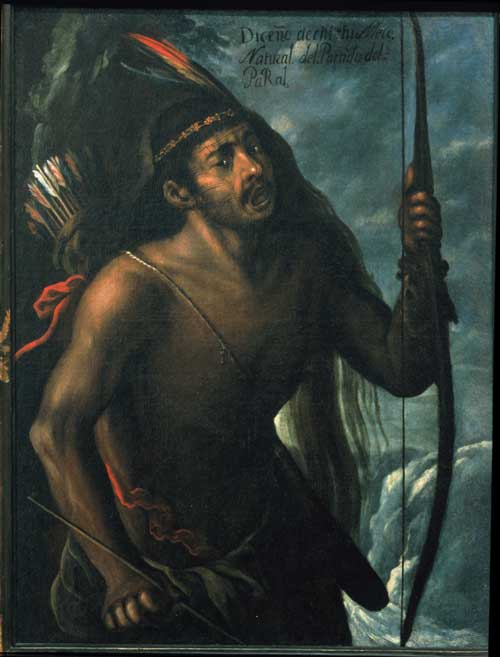La invención del mestizaje: La pintura de castas y el siglo XVIII en México
Los Angeles County Museum of Art, LA
4 April-8 August 2004

Manuel Arellano. Diceño de chichimeco (Rendition of a Chichimeco), 1711. Oil on canvas. Museo de América, Madrid
The exhibition is a collection of casta ('caste') paintings, created primarily in the 18th century, for the European market as providing evidence of the seemingly harmonious mixing of races in Mexico. But there is an underlying agenda here which, while attempting to demonstrate the extent to which the status of a family group is lowered when cultures mix, actually portrays the Spaniards as the number one race.
On first entering the gallery, you find a collection of paintings that appear merely to depict people dressed in different costumes with careful and elegant poses. There are also word captions inscribed on the paintings though the connection with the words is not immediately clear. But once you properly focus on the painting, and read the text, it is no longer possible to just look at the works themselves; you are compelled to read every phrase about them and grapple with the flood of emotions - ranging from anger to sadness to outrage - that they inspire, for those 'unfortunates', born to mixed race parents. These works actually come to represent the cruel oppression and outright criminal legacy of the colonial Spanish culture.
To follow are just a selection of the accompanying text.
From Spaniard and Black, a Mulato is born.
From Spaniard and Mulato, a Morisco is born.
From Spaniard and Indian, a Mestizo is born, generally humble, quiet and unassuming.
Mulato and Indian make a Calpamulato, of impulsive temper, strong and stocky.
From Indian and Calpamulato a Jibaro is born, usually restless and always arrogant.
From Spaniard and Mestizo, their fondness of horses is passed to a Castizo.
From Castizo and Spaniard, a Spaniard is born.
From Spaniard and Morisca, an Albino is born, nearsighted, weak, gentle and benign
From Spaniard and Castiza, the beautiful result resembles her father in every way.
From Mestizo and Indian, a Coyote is born.
From Black and Indian, a Wolf is born, bad ilk, and astute pickpockets.
From Wolf and Indian, a Cambujo is born, usually dense, lazy and slow-witted.
One must add here that it is sad (to say the least) that most of the above sentiments are still very much alive today in the global culture, and the habit of labelling people is still actively and fundamentally detrimental to race relations. Because of the negative phrases here applied on each painting, this exhibition forces one to confront the issues of race unequivocally, and hopefully to seek solutions in mitigation.
Miguel Benavides